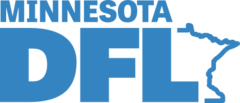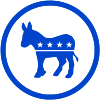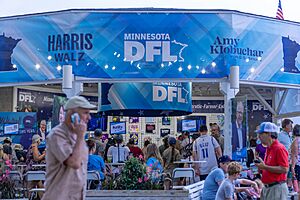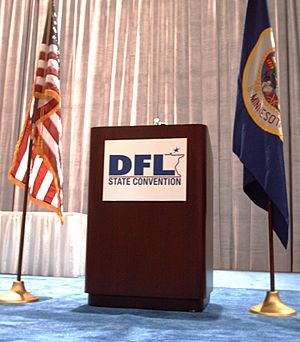Minnesota Democratic–Farmer–Labor Party facts for kids
Quick facts for kids
Minnesota Democratic–Farmer–Labor Party
|
|
|---|---|
 |
|
| Abbreviation | DFL |
| Chairperson | Richard Carlbom |
| Governor | Tim Walz |
| Lieutenant Governor | Peggy Flanagan |
| Senate President | Bobby Joe Champion |
| Senate Leader | Erin Murphy |
| House Leader | Vacant |
| Founded | April 15, 1944 |
| Merger of | Minnesota Democratic Party and Minnesota Farmer–Labor Party |
| Headquarters | 255 Plato Boulevard East Saint Paul, Minnesota |
| Youth wing | Minnesota Young DFL (MYDFL) |
| Ideology | Modern liberalism Progressivism Factions: Left-wing populism Democratic socialism |
| Political position | Center-left Factions: Left-wing |
| National affiliation | Democratic Party |
| Colors | Blue |
| State Senate |
34 / 67
|
| State House |
66 / 134
|
| Statewide Executive Offices |
5 / 5
|
| U.S. Senate |
2 / 2
|
| U.S. House of Representatives |
4 / 8
|
| Election symbol | |
 |
|
The Minnesota Democratic–Farmer–Labor Party (DFL) is a political party in the U.S. state of Minnesota. It is connected to the national Democratic Party. The DFL was created in 1944 when the Minnesota Democratic Party and the Minnesota Farmer–Labor Party joined together. It is one of only two state Democratic Party groups that have a different name from the national party.
The DFL is currently the main political party in Minnesota. It holds four of Minnesota's eight seats in the U.S. House, both of its U.S. Senate seats, and controls the Minnesota Senate. The DFL also holds all other statewide offices, including the governorship. The party's main political opponent is the Republican Party of Minnesota.
Contents
Party History
During the 1930s, the Minnesota Farmer–Labor Party became popular. It pushed for big changes to address economic and social unfairness. However, by 1938, the party lost some of its power due to disagreements within the group.
On April 15, 1944, the Farmer–Labor Party merged with the Minnesota Democratic Party. This created the Democratic-Farmer-Labor Party (DFL). Key leaders like Elmer Kelm, Elmer Benson, and Hubert Humphrey helped make this merger happen. This change was also influenced by university thinkers who wanted to combine the New Deal ideas into a more organized political system.
After World War II, the DFL dealt with important social issues. This included fighting against unfair treatment of people based on their background. The party also worked on civil rights and economic fairness. These efforts were strongly influenced by Minnesota's active African American communities.
The party also had internal debates about its direction. Some leaders, like Hubert Humphrey, wanted a more moderate approach. Others supported more progressive ideas. By 1954, Orville Freeman, a moderate leader, became Minnesota's first DFL governor. Important members of the DFL have included Hubert Humphrey and Walter Mondale. Both became Vice Presidents and ran for President. Other notable figures include Eugene McCarthy, Paul Wellstone, Amy Klobuchar, Dean Phillips, and Governor Tim Walz.
After the 2022 Minnesota elections, the DFL became very strong in the state. They won every top executive office and majorities in both the state House and Senate. They also re-elected all their members of Congress. With this strong position, the DFL passed many new laws. Governor Tim Walz called it a very successful legislative session. New laws included expanding healthcare access and paid sick leave for workers. Former president Barack Obama praised Minnesota's actions.
How the Party Works
The DFL is run by a state central committee. This committee has representatives from different areas of the state. It decides the party's goals and chooses party leaders. The DFL also has rules, like a constitution and bylaws, that guide how it operates.
Community Groups
The DFL has several community groups called caucuses. These groups help organize and represent different communities in Minnesota. They are not based on geography. Some of these groups include:
- African American Caucus: For African Americans.
- Asian Pacific American Caucus: For Asian Americans and Pacific Islander Americans.
- Disability Caucus: Supports Minnesotans with disabilities.
- Environmental Caucus: Works for environmental protection.
- Feminist Caucus: Focuses on feminist and women's issues.
- Hmong American Caucus: For Hmong Americans, a large Asian American group in Minnesota.
- Latino Caucus (Movimiento): For Latino Americans.
- Minnesota Young DFL: For young people.
- Muslim Caucus: For Muslims in the state.
- Native People's Caucus: Supports Native Americans and tribal communities.
- Progressive Caucus: Promotes progressive policies.
- Rural Caucus: Supports the state's rural communities.
- Senior Caucus: Works for the interests of senior citizens.
- Somali American Caucus: For Somali Americans.
- Stonewall DFL: For LGBTQ+ Minnesotans.
- Veterans Caucus: For veterans and their families.
Who Supports the DFL
The DFL gets support from many different types of voters. This includes people in cities and suburbs, working class voters, and members of labor unions. Environmental groups and other progressive organizations also support the party. The DFL is very strong in the Twin Cities metropolitan area.
Current Elected Officials
Federal Officials
U.S. Senate
- Amy Klobuchar (since 2007)
- Tina Smith (since 2018)
U.S. House of Representatives
The DFL holds four of Minnesota's eight seats in the U.S. House.
- 2nd district: Angie Craig (since 2019)
- 3rd district: Kelly Morrison (since 2025)
- 4th district: Betty McCollum (since 2001)
- 5th district: Ilhan Omar (since 2019)
State Officials
Statewide Offices
- Governor: Tim Walz (since 2019)
- Lieutenant Governor: Peggy Flanagan (since 2019)
- Secretary of State: Steve Simon (since 2015)
- State Auditor: Julie Blaha (since 2019)
- Attorney General: Keith Ellison (since 2019)
State Legislative Leaders
- President of the Senate: Bobby Joe Champion (since 2023)
- Senate Majority Leader: Erin Murphy (since 2023)
City Mayors
- Minneapolis: Jacob Frey (since 2018)
- Saint Paul: Melvin Carter (since 2018)
- Duluth: Roger Reinert (since 2024)
Party Leadership

Current Leaders
- Chair: Richard Carlbom (since 2025)
- Vice Chair: Marge Hoffa (since 2011)
- Second Vice Chair: Shivanthi Sathanandan (since 2021)
- Treasurer: Lindy Sowmick (since 2025)
- Secretary: Ceri Everett (since 2021)
- Outreach Officer: Quentin Wathum-Ocama (since 2025)
Past Party Chairs
For many years, the DFL had both a chairman and a chairwoman. Later, the titles changed to chair and associate chair, with both being paid and needing to be of opposite genders.
- Some notable past chairs include Elmer Kelm (1944–1946), Orville Freeman (1948–1950), and Koryne Horbal (1968–1977).
- More recent chairs include Mike Hatch (1980–1983), Todd Otis (1990–1993), Mark Andrew (1995–1997), Mike Erlandson (1999–2005), and Ken Martin (2011–2025).
See also
 In Spanish: Partido Demócrata-Agrario-Laborista de Minesota para niños
In Spanish: Partido Demócrata-Agrario-Laborista de Minesota para niños
- List of political parties in Minnesota
- Political party strength in Minnesota
- Politics of Minnesota


